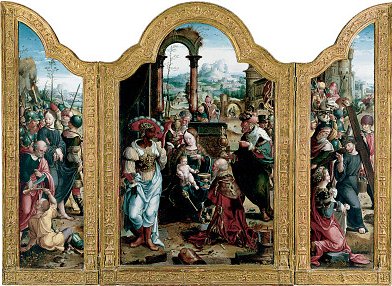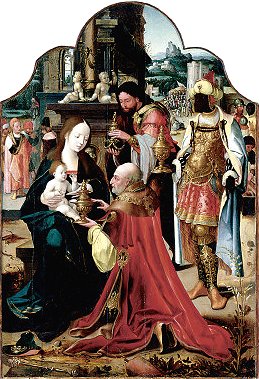ADORATION OF THE MAGI (on the right)
Jan Mertens (also called Jan van Dornike and "The master of 1518")
Early Netherlandish 1470-1527. SN 927. Oil on Panel 1520's

by Pieter Coeke van Aelst. Son-in-law and student of Jan Mertens.
Look how similar the central subjects are painted
|
|

by Jan Mertens |
by Robert Anderson
ARTIST
One of the leading painters of his time in Antwerp, Jan Mertens was the
son of the sculptor, Jan Mertens the Elder. He was a respected member of the Antwerp Guild
of St. Luke and became a master of the Guild in 1509. His work is Antwerp Mannerism and is
distinguished by its brilliant color, sense of structure, thoughtful composition and
delicacy of style.
SUBJECT
The subject is the adoration of the Christ child by three kings / magi
from the East who had seen his star in the East and had come to worship him - who was to
be King of the Jews. The three present Jesus with their gifts of gold, frankincense, and
Myrrh.
New Testament - St. Matthew 2: 1-12.
PAINTING
This painting is elegant and elaborate. The style is now called Antwerp
Mannerism
- a style in which painters reacted against standards established by the masters of the
High Renaissance by emphasizing subjective visions of religious experience.
The painting is illustrative of the influence of Italian Renaissance
art on Flemish painters. Mertens shows off his ability to evoke the Roman classical past
in his ornate classical architecture and in the detailed armor of the Moorish magus.
Notice the difference between Antwerp Mannerism and Early Netherlandish art by comparing
the idealized face of the Virgin in this painting with the plainer features of "The
Madonna in an Apse " by a follower of Robert Campin.
There is much symbolism present in this painting :
- Behind the Christ child is a column symbolizing the passion and to which he will be
bound for his flagellation.
- There is a profile cameo of a Roman governor at the column's base.
- To the left of the columns in the middle distance there is an image of Judas accepting
the 30 pieces of silver.
- In the distance a company of foot soldiers are on their way to Gethsemane to arrest
Jesus.
- In the far distance is a city - the symbol of the city of God - described by St John the
Evangelist in the Apocalypse.
- Christ holds a pearl. Two references in Matthew describe the pearl as symbolic of
God’s salvation, worth more than earthly treasure.
- Caspar, the eldest, who would normally command the most respect, is on his knees. This
illustrates the power of earth subservient to the power of Heaven, the spiritual importance
of God’s son as mankind’s savior.
- The gifts are symbolic: gold acknowledges Christ as King; frankincense (a sacred incense), His
divinity; myrrh (a perfumed essence used in funeral preparations), foreshadows Christ’s
death.
- On another level, the three magi represent the three ages of man paying homage to Christ.
HISTORICAL CONTEXT
This subject was a favorite of Antwerp Mannerists because it afforded a
full range of exotic types in the three kings and a rich display of decoration in their
offerings. Mertens was the teacher and father-in-law of
Pieter Coeke van Aelst, and through him an important bridge to the next
generation of artists.
Another slant on interpreting the painting: the three known continents (Europe, Asia, and Africa) are personified as being in one spot to worship the new King of Kings. This presence had a deep significance for the great port city of Antwerp as a hub of world trade.
Antwerp also sponsored a powerful artists’ Guild system which assured the quality exemplified by the fine craftsmanship and glossy surface seen here. Note also the handsome “bell” frame, contemporary with the painting.
Like the Italian Mannerists, these Northerners felt that the “ideal” which had become the norm had reached perfection and couldn’t develop any further. So artists began to emphasize subjective visions of the religious experience.
Early Antwerp Mannerism is characterized by:
Contorted poses: note the black magus’ elegant but exaggerated stance.
Irrational space: the scale is inconsistent when you consider how big the background mountain must be, compared with the tiny figures in the middle distance.
Elaborate surface decoration.
But High Renaissance Classicism is apparent in:
The sculptural putti.
The Italian classical architecture.
Further notes [from Smithsonian Magazine, 12/86]:
Frankincense: was considered sacred. The gathering of its sticky resin from small trees (grown only in northern Somalia & southern Arabia) was restricted to 3000 specially appointed families. They, too, were considered sacred and observed many taboos – e.g., sex and going to funerals was prohibited during harvest time! Employees at the shipping centers were subjected to body searches, and had to wear nets over their heads to prevent theft.
Families burned frankincense at the altars of household gods, and it was regularly used at funerals. One way to display wealth was to toss extravagant amounts on a pyre. In the currency of the1980s, it was worth $500 a lb.
Myrrh: cost even more, up to $4000 a pound. It was used in medicines, cosmetics, and perfumes. The “fair young virgins” rounded up for King Ahasuerus (including Esther; see Gal. 6, Palma’s Esther Before King Ahasuerus) received six months of massage with myrrh to qualify them for the royal nostrils. Current experiments have proved myrrh may indeed promote healing when used as an antiseptic.
ringlingdocents.org
|

